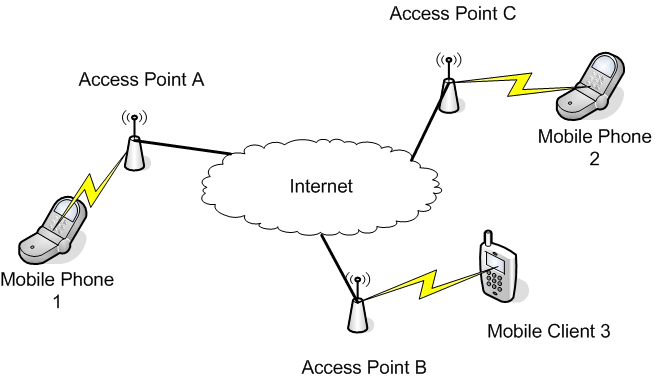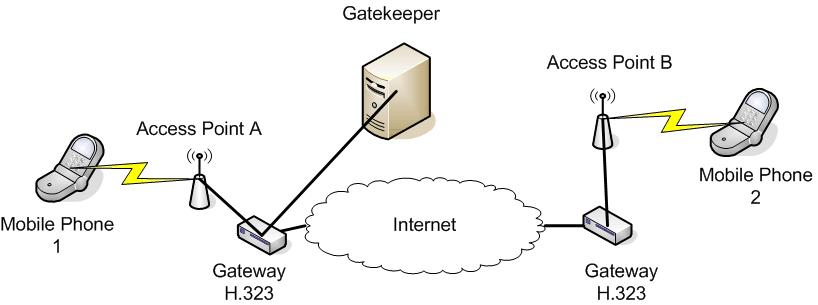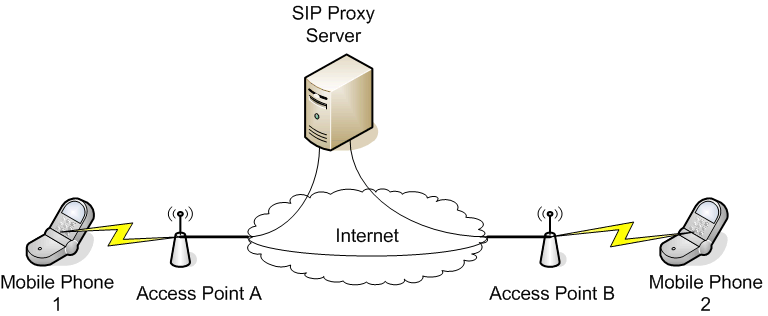Voice over Wireless Data Networks
G. Adam Covington,
Abstract
As wireless technology becomes increasingly available it only makes
sense that applications like Voice over IP (VoIP) would be
implemented. The merging of two areas, VoIP and wireless networks,
has created Voice over WiFI (VoWiFi). Problems with VoIP are not
only ported to wireless networks, they are also magnified. Mobility
is an issue with wired networks, however wireless networks require
mobility on a much larger scale. This paper focuses on some
underlying issues of VoIP and VoWiFi. It also presets some
background on protocols and codecs used with telephony data.
Keywords
VoIP, VoWiFi, 802.11i, 802.11r, 802.11e, Codecs, RVP/IP, SIP
Table of Contents
Introduction
Voice over IP (VoIP) is an area of research and development that has
been reported on extensively. This area as created to leverage the
current wired computer networks to transmit multimedia. In
particular, the transmission of voice has been a very important
area. Wired networks can provide all the necessary functions to
transmit voice traffic. However, there are inherent problems with
voice over wired IP networks. An example of such a problem can be
seen with the TCP/IP protocol. This protocol does not have any
quality of service guarantees. Such guarantees are important with
multimedia. With voice a caller and the called would prefer little
to no delay.
As Wireless technology becomes more popular and implemented in
mainstream networks, it is only natural for applications such as
VoIP to be implemented. The new joint area is called Voice over
Wireless Data Networks. This area covers Voice over Wi-Fi (VoWiFi)
as well as Voice over Wimax, but excludes cellular networks. The
idea of VoWiFi is to utilize existing wireless technology that is
used for computer networks to transport voice traffic. Such
computer networks can be thought of as Data Networks, since the
original purpose was to transmit data from computer to computer.
This newly merged area of research maintains most, if not all, of
the wired network problems with voice traffic. In addition,
mobility and security become a bigger problem. With individuals
traveling to and from subnetworks issues of handoff and connectivity
become apparent. This report will identify three problem areas and
discuss solutions that are currently under development. It will also
present some fundamental information about codec, and protocols that
have been developed for voice traffic.
Back to the Table of Contents
2. Main Issues and Solutions
Voice over Wireless Networks has the same issues as VoIP. Quality
of Voice, and Scalability are important to the use of VoIP. In
addition to these issues, Quality of Service, Mobility, and Security
of telephony traffic are more problematic in wireless networks.
These issues or problems are currently being explored for wired and
wireless networks in general. These solutions are being adopted
within implementations of VoIP and VoWiFi products. As more products
are created for telephony over data networks, more solutions are
added by creating new protocols and services that help maintain
voice traffic.

Fig 1. Example Voice over WiFi network
2.1 Quality of Service
The current group that is adding Quality of Service (QoS) to the
wireless standards is 802.11e. This standard includes two types of
QoS: Prioritized, and Parameterized.
Prioritized QoS implements different queues for priorities. Traffic
is given a tag that is used to target a queue. By using tagging and
different queues types of traffic (i.e. voice) can get priority.
This implementation allows for priority, however there is no
guarantee on the amount of bandwidth given to a priority or queue.
The second type of QoS, Parameterized QoS, allows for a bandwidth
guarantee. This guarantee (for streams) provides applications such
as VoWiFi the ability to maintain throughput.
[VoWiFi Standards]
2.2 Mobility
When talking about wireless networks mobility is an important
consideration. Applications running on a network need the ability
to continue running when transferring from one area to another.
For example, in Figure 1 if Mobile Phone 2 where to move further
south it would require it to switch to Access Point B. In this
example Mobile Phone 2 would need to negotiate with Access Point B
and prepare for the switch. After switching Mobile Phone be would
have to deassociate with Access Point C. In
addition to connecting to one access point it also need to be able
to disassociate from it current access point. The 802.11r standard
is currently being developed that allows for fast hand-offs. The
standard allows a user to connect and negotiate security and QoS
settings before dissociating with it's current access point. This
allows a mobile user to maintain service as access points are
changed. For indepth information refer to the IEEE 802.11r standard.
It is also
explained at [802.11r explained].
2.3 Security
Security is an important topic in networking. It is only natural
that security concerns are present in both wireless networks and the
applications running on the networks. With in the application of
Voice over Wireless networks the main security concerns revolve
around confidentiality, data integrity, and data source
authentication. The wireless standard 802.11i addresses these
problems within wireless networks and provides the necessary
functionality. There are currently two versions for security:
Temporal Key Integrity Protocol, and Counter Mode with Cipher Block
Chaining Message Authentication Code Protocol.
Temporal Key Integrity Protocol (TKIP) is an important first step in
security. The TKIP algorithm is designed so that it can be
implemented in current hardware with only firmware upgrades. It
uses an algorithm called Michael to check the integrity of the
message. Michael uses the RC4 hashing algorithm, however it is used
in a secure form. In addition TKIP allows for rapid re-keying.
A more secure protocol is called Counter Mode with Cipher Block
Chaining Message Authentication Code Protocol (CCMP). CCMP is much
stronger than TKIP. It utilizes the Advanced Encryption Standard
(AES). This protocol requires new hardware that can implement the
AES encryption and decryption. [VoWiFi Standards]
Back to the Table of Contents
3. Codecs
The quality of voice is a characteristic on digital telephony. Since
VoIP and VoWiFi combine digital telephony and networking
technologies they also have the quality of voice characteristic. An
important element that controls the quality of voice is the
compression, and conversion of analog to digital (codec) used on the
voice traffic. There are numerous codecs defined for use with voice
traffic. The following sections will introduce and give an overview
of a few current codecs in use.
3.1 Global System for Mobile communications
The Global System for Mobile communications (GSM) is a popular codec
used in cell phone networks in Europe. The codec samples the audio
signal to produce a digital equivalent. The current sampling is
determined by the previous samples. This assumes that the streaming
data (voice in this case) does not change quickly. The samples are
then passed to the codec at 13 kbps. The sampling rate is 8 kHz and
the frame size is 22.5 ms. A more detailed description of the GSM
protocol can be found at [GSM].

Fig 2. Analog Voice is Sampled and may be compressed by the Codec into a Digital Form
3.2 G.711
The G.711 codec is a standard adopted in 1988, that is used in
modern digital telephony. The advantage of this codec is that there
is no compression of the signal. This means that there is no
additional processing needed for compression and decompression.
Using an uncompressed signal means that there is an increased amount of
bandwidth required for transmission. This codec can require up to
84 Kbps when all the TCP/IP headers are taken into consideration.
This codec has a sampling rate of 8 KHz, and a bit rate of 32 kb/s.
Pulse code modulation (PCM) is used to sample the stream. There are
two variations of this codec: U-law and A-law. For more information
on G.711 please refer to [G.711].
3.3 G.722
This codec divides a 16 kHz frequency band into two sub-bands.
Adaptive Differential Pulse Code Modulation (ADPCM) is used on each
of the sub-bands for coding. This codec provides a bit rate of 64
kb/s with a sampling rate of 16 kHz. More information of the codec
can be found at [G.722].
3.4 G.723.1
The G.723.1 codec is used for compressing audio at very low bit
rates. The principle application that this codec is targeting is
visual telephony. It is part of a larger family of standards,
H.324. The codec has a dual rate speech coder that can handle a
data rate of 5.6 kb/s and 6.3 kb/s. The codec uses a sampling rate
of 8 kHz and a frame size of 30 ms. A more in depth look at the
codec can be found at [G.723.1]. In order
to use this codec a license must be obtained from
Sipro Lab Telecom.
3.5 Codec Summary
One of the most common ways to determine the quality of a codec is
to determine the Mean Opinion Score (MOS). The MOS is a value
between one and five. A score of one means there is a
communications breakdown. An excellent score is a five. This is
equivalent to a perfect AM radio reception. Current land line
telephony achieves a score of four. The closer a codec is to a
score of four represents a small difference between the codec and
current land line systems. The following table was compiled
primarily from [Codec Table], but
also information found in numerous journal papers.
| Codec |
Bitrate (kb/s) |
Sampling (kHz> |
Frame Size (ms) |
MOS |
| GSM |
13 |
8 |
22.5 |
3.5 |
| G.711 |
32 |
8 |
Sample |
4 |
| G.722 |
64 |
16 |
Sample |
3.6 |
| G.723.1 |
5.6/6.3 |
8 |
30 |
3.8 |
| G.729 |
8 |
8 |
10 |
4.02 |
Back to the Table of Contents
4. Protocols
There have been a few protocols that have been developed for voice
and multimedia data. The protocols help to define what is needed in
a physical network to help facilitate voice traffic. The first
protocol that was developed that identified and solved many issues
of voice traffic was called H.323. After discussing the Session
Initiation Protocol will be introduced and described. Within this
paper these are the only two that will be discussed.
4.1 H.323
H.323 is the International Telecommunication Unit's (ITU) protocol
for establishing VoIP connections. The standard was the first to
solve the issues of VoIP over networks. The standard contains three
primary components: Call Processing Servers, Media Gateways, and
Gatekeepers.
Call processing servers handle call routing. In addition, it allows
for communication to VoIP gateways and any end user devices. The
media gateways provide an interface with non-H.323 networks in
addition to being the protocols termination node. The gatekeepers
(although not necessary) provide the functions of call admission
control, call signaling and bandwidth management as a co-located
unit. The gatekeepers allow the protocol to be highly scalable by
taking the call control and management from the gateways. For a more
look at the protocol refer to [H.323].

Fig 3. Example of a H.323 network with a Gatekeeper
Within Figure 3 it can be seen how an example voice over wireless
networks would incorporate the H.323 protocol. If Mobile Phone 1
were to place a call it would contact the gatekeeper for the address
of the second party (Mobile Phone 2). It would then contact Mobile
Phone 2 and they would use the H.323 protocol to set up a connection
and start data transmission.
4.2 Session Initiation Protocol
An application-layer control protocol called Session Initiation
Protocol (SIP) is utilized in VoIP to establish, modify and
terminate connections. The protocol allows for call forwarding,
authentication, multicast conferencing, and automatic call
distribution. SIP allows for mobility by providing a transparent
name mapping. There are six methods that are supported in the SIP
protocol: INVITE, ACK, OPTIONS, BYE, CANCEL, REGISTER. The details
of the SIP protocol can be found in the RFC2543
[RFC2543].
Over the past few years the original SIP protocol has been extended
and modified to alleviate problems. Currently there are three
additional RFCs that extend the protocol. RFC4320
[RFC4320]is
provides a solution to the SIP non-INVITE operation. This RFC shows
modifications that can reduce network traffic and improves the
robustness of SIP networks. Extending the reason header for
preemption events is described in RFC4411 [RFC4411].

Fig 4. Example of SIP being used for Voice over wireless network
Figure 4 shows an example of the protocol SIP being utilized for
voice over a wireless network. When working in a redirect mode the
connection sequence would be as follows. Both phones would register
with the SIP proxy server. Mobile Phone 1 would they send a request
to the server trying to connect to Mobile Phone 2. The SIP server
would then send Mobile Phone 2 a message stating that there is a
connection request. When Mobile Phone 2 picks up the SIP protocol
then sets up an RTP connection between the two phones.
[Juniper].
Back to the Table of Contents
5. Summary
Voice over wireless data networks suffer from the same problems as
Voice over IP. Some of these problems are magnified due to the
natural mobility wireless products offer. With in the 802.11
standards there are standards that are being developed to provide
solutions to some of these issues. For security, 802.11i is under
production. Mobility should be increased with the hand-off
characteristics being developed in 802.11r.
Quality of Voice is a complex issue and is being addressed in at
least two ways. In the standard 802.11e priority queues are
utilized to help ensure the throughput of Voice and other multimedia
traffic. Voice quality is also determined by the codec that is
chosen and implemented. The codec is important, because the
sampling and the compression ratio can drastically decrease the
quality. A score called MOS is used to determine the quality of
telephony.
Two protocols were also introduced and discussed. These protocols
were created with voice and multimedia in mind. They are used to
help provide a basis for creating, maintaining, and closing
connections between callers. The first protocol introduced was the
H.323, but it is no in competition with the protocol called SIP.
Back to the Table of Contents
References
[VoWiFi Standards] "VoWiFi standards situation",
http://www.networkworld.com/research/2004/0503vowifiside.html?page=1
Talks about VoWiFi standards (specifically 802.11 standards)
[802.11r explained] "802.11r strengthens wireless voice",
http://www.techworld.com/mobility/features/index.cfm?featureid=1701
Article that explains the necessity of 802.11r in VoWiFi
[GSM] "GSM Codec",
http://www.shoshin.uwaterloo.ca/~jscouria/GSM/index.html
Website that provides an extensive amount of information on the GSM codec
[G.711] "ITU G.711",
http://www.voip-info.org/wiki/view/ITU+G.711
Website that provides information on the G.711 codec
[G.711] "The CCITT G.722 Wideband Speech Coding Standard",
http://www.umiacs.umd.edu/~desin/Speech1/node3.html
Website that provides information on the G.722 codec
[G.723.1] "G.723.1 Dual Rate Speech Coder for Multimedia Communications Transmitting at 5.3 and 6.3 kbit/s",
http://www.vocal.com/data_sheets/g723d1.html
Website that provides information on the G.723.1 codec
[Codec Table] "Audio codecs",
http://www.cs.columbia.edu/~hgs/audio/codecs.html
Website that provides information on the G.723.1 codec
[H.323] ITU, "Packet Based Multimedia Communications Systems", Feb 1998, 125 pages
This describes the H.323 standard
[RFC2543] "SIP : Session Initiation Protocol", March 1999, 132 pages,
ftp://ftp.rfc-editor.org/in-notes/rfc2543.txt
Defines the SIP protocol.
[RFC4320] "Actions Addressing Identified Issues with the Session Initiation Protocol's (SIP) Non-INVITE Transaction", January 2006, 7 pages,
ftp://ftp.rfc-editor.org/in-notes/rfc4320.txt
Defines a modification to SIP for non-INVITE.
[RFC4411] "Extending the Session Initiation Protocol (SIP) Reason Header for Preemption Events", February 2006, 22 pages,
ftp://ftp.rfc-editor.org/in-notes/rfc4411.txt
Defines extension to SIP for preemption.
[RFC4412] "Communications Resource Priority for the Session Initiation Protocol (SIP)", February 2006, 36 pages,
ftp://ftp.rfc-editor.org/in-notes/rfc4412.txt
Defines resource priority for SIP.
[Juniper] "Voice Over IP 101 Understanding VoIP Networks", January 2006, 23 pages,
http://www.juniper.net/solutions/literature/white_papers/200087.pdf
Describes the various protocols and gives examples.
Back to the Table of Contents
List of Acronyms
| IP |
Internet Protocol |
| VoIP |
Voice over IP |
| VoWiFi |
Voice over WiFi |
| GSM |
Global System for Mobile communications |
| MOS |
Mean Opinion Score |
| TKIP |
Temporal Key Integrity Protocol |
| CCMP |
Cipher Clock Chaining Message Authentication Code Protocol |
| AES |
Advanced Encryption Standard |
| PCM |
Pulse-code Modulation |
| ADPCM |
Adaptive Differential Pulse Code Modulation |
| SIP |
Session Initiation Protocol |
Back to the Table of Contents




